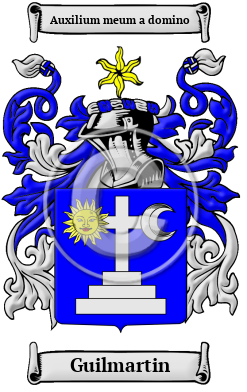| ![Show Contents]() Guilmartin History, Family Crest & Coats of Arms Guilmartin History, Family Crest & Coats of Arms
Etymology of GuilmartinWhat does the name Guilmartin mean? The original Gaelic form of Guilmartin was Mac Giolla Mhartain. This name denotes a devotee of St. Martin. This saint founded the first monastery in France c. 360 and was made Bishop of Tours in 372. He is the patron saint of publicans and inn-keepers and is also a patron saint of France. Early Origins of the Guilmartin familyThe surname Guilmartin was first found in County Galway (Irish: Gaillimh) part of the province of Connacht, located on the west coast of the Island, where they had been granted lands by Strongbow after the Norman invasion of Ireland in 1172, and became one of the "Tribes of Galway." Kilmartin is a small village in Argyll and Bute, in western Scotland. It is best known as the center of Kilmartin Glen, one of the best examples of standing stones in Scotland. Kilmartin Castle, a small tower house, dating from about 1580, stands above the village and was the property of the Campbells. Early History of the Guilmartin familyThis web page shows only a small excerpt of our Guilmartin research. Another 76 words (5 lines of text) covering the years 1600, 1648, 1652 and 1722 are included under the topic Early Guilmartin History in all our PDF Extended History products and printed products wherever possible. Guilmartin Spelling VariationsThe Middle Ages saw a great number of spelling variations for surnames common to the Irish landscape. One reason for these variations is the fact that surnames were not rigidly fixed by this period because the general population had to rely on local official's understanding of how their name should be spelt, hence spellings in records often changed through a person's lifetime. The following variations for the name Guilmartin were encountered in the archives: Gilmartin, Kilmartin, MacKilmartin, MacGilmartin and many more. Early Notables of the Guilmartin familyAnother 35 words (2 lines of text) are included under the topic Early Guilmartin Notables in all our PDF Extended History products and printed products wherever possible.
| Guilmartin migration to the United States | + |
Ireland became inhospitable for many native Irish families in the 19th centuries. Poverty, lack of opportunities, high rents, and discrimination forced thousands to leave the island for North America. The largest exodus of Irish settlers occurred with the Great Potato Famine of the late 1840s. For these immigrants the journey to British North America and the United States was long and dangerous and many did not live to see the shores of those new lands. Those who did make it were essential to the development of what would become two of the wealthiest and most powerful nations of the world. These Irish immigrants were not only important for peopling the new settlements and cities, they also provided the manpower needed for the many industrial and agricultural projects so essential to these growing nations. Immigration and passenger lists have documented the arrival of various people bearing the name Guilmartin to North America:
Guilmartin Settlers in United States in the 19th Century- John Guilmartin, who landed in Savanna(h), Georgia in 1822 1
| Guilmartin migration to Australia | + |
Guilmartin Settlers in Australia in the 19th Century- Mr. Malachy Guilmartin, (b. 1796), aged 26, Irish shearman who was convicted in Tipperary, Ireland for 7 years, transported aboard the "Brampton" on 8th November 1822, arriving in New South Wales, Australia 2
- Mr. Mathias Guilmartin, (b. 1808), aged 30, Irish labourer who was convicted in Tipperary, Ireland for 15 years for stealing, transported aboard the "Clyde" on 11th May 1838, arriving in New South Wales, Australia 3
| Contemporary Notables of the name Guilmartin (post 1700) | + |
- James L. Guilmartin, American Republican politician, U.S. Attorney for the Southern District of Florida, 1953-59; Alternate Delegate to Republican National Convention from Florida, 1964 4
The motto was originally a war cry or slogan. Mottoes first began to be shown with arms in the 14th and 15th centuries, but were not in general use until the 17th century. Thus the oldest coats of arms generally do not include a motto. Mottoes seldom form part of the grant of arms: Under most heraldic authorities, a motto is an optional component of the coat of arms, and can be added to or changed at will; many families have chosen not to display a motto.
Motto: Auxilium meum a domino
Motto Translation: My help is from the Lord.
- Filby, P. William, Meyer, Mary K., Passenger and immigration lists index : a guide to published arrival records of about 500,000 passengers who came to the United States and Canada in the seventeenth, eighteenth, and nineteenth centuries. 1982-1985 Cumulated Supplements in Four Volumes Detroit, Mich. : Gale Research Co., 1985, Print (ISBN 0-8103-1795-8)
- Convict Records Voyages to Australia (Retrieved 29th October 2020). Retrieved from https://convictrecords.com.au/ships/Brampton
- Convict Records Voyages to Australia (Retrieved 24th February 2021). Retrieved from https://convictrecords.com.au/ships/clyde
- The Political Graveyard: Alphabetical Name Index. (Retrieved 2016, January 20) . Retrieved from http://politicalgraveyard.com/alpha/index.html
 |

